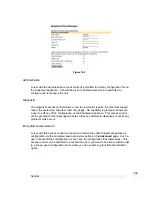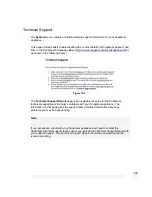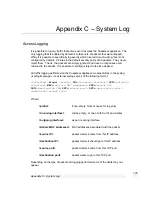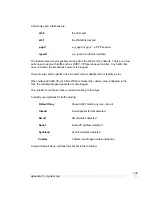
173
RSA Digital
Signatures
A public/private RSA key pair used for authentication. The SnapGear
appliance can generate these key pairs. The public keys need to be
exchanged between the two parties in order to configure the tunnel.
SHA
Secure Hash Algorithm, a 160 bit hash. It is one of two message digest
algorithms available in IPSec.
Security
Parameter Index
(SPI)
Security Parameter Index, an index used within IPsec to keep
connections distinct. Without the SPI, two connections to the same
gateway using the same protocol could not be distinguished.
Subnet mask
See "Net mask".
Switch
A network device that is similar to a hub, but much smarter. Although
not a full router, a switch partically understands how to route Internet
packets. A switch increases LAN efficiency by utilizing bandwidth more
effectively.
TCP/IP
Transmission Control Protocol/Internet Protocol. The basic protocol for
Internet communication.
TCP/IP address
Fundamental Internet addressing method that uses the form
nnn.nnn.nnn.nnn.
TripleDES
(3DES)
Using three DES encryptions on a single data block, with at least two
different keys, to get higher security than is available from a single DES
pass.
UTC
Coordinated Universal Time.
UTP
Unshielded Twisted Pair cabling. A type of Ethernet cable that can
operate up to 100Mb/s. Also known as Category 5 or CAT 5.
VPN
Virtual Private Networking. When two locations commmunicate
securely and effectively across a public network (e.g. the Internet).
The three key features of VPN technology are privacy (nobody can see
what you are communicating), authentication (you know who you are
communicating with), and integrity (nobody can tamper with your
messages/data).
WAN
Wide Area Network.
WINS
Windows Internet Naming Service that manages the association of
workstation names and locations with IP addresses.
x.509 Certificates
An x.509 certificate includes the format of the certificate, the serial
number of the certificate, the algorithm used to sign the certificate, the
name of the CA that issued the certificate, the name and public key of
the entity requesting the certificate, and the CA's signature.x.509
certificates are used to authenticate the remote party against a
Certificate Authority's (CA) certificate. The CA certificate must have
signed the local certificates that are used for tunnel authentication.
Certificates need to be uploaded into the SnapGear before a tunnel can
be configured to use them (see Certificate Management).





























